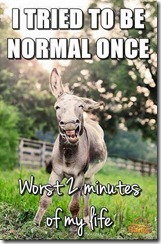Spring
Although all work the sugar house is wrapped up for the season there are still a couple rainy day jobs left, priority being half a dozen wooden crates must be made for shipping syrup to customers in the west. Some lumber is retrieved from the mow over the horse barn, measurements made so boards can be cut to the appropriate length for a crate to fit the order with a hand saw, bottom and sides nailed together, the ordered quart cans placed inside then the lid nailed on. Now comes the cool part, with the crates loaded in the ‘48 Chevy, we change into going to town clothes fire up the car and go to the CN Rail station in Cowansville where the crates are unloaded at the freight shed with the requisite paper work filled out. The train station is a magical place to a 3 yr. old with it’s smells of coal, creosote mingling with the sight of the steal rails heading endless miles to the west forms an aura of excitement and adventure! Little did I know then that one day I would ride those very same rails west to Edmonton.
The other rainy day job was soldering the leaky buckets, for this father used an electric soldering iron, taking a wire brush the area around the leak was cleaned and roughed up so the solder would adhere, the heated iron placed on the hole just long enough to heat it up then the end of the roll of acid-core solder touched to the hot tin at the hole where the solder liquefies running into the hole sealing it as it cools. When all the buckets are repaired they are returned to the sugar house and when the truck from the co-op picks up the drum of industrial grade syrup sugaring season is really over.
Once the cheques from the syrup sales are in it’s time to head to town to pay the farm’s taxes as April is tax time. The secretary at Heroes Memorial School in Cowansville was charged with the duty of collecting the areas property taxes so a visit to him one must pay. Should the season be a good one, there will be money left over from sugaring, a poor one may mean dipping into the bank account.
The first real job of spring is fence mending as the winter snow loads tend to be hard on any weak spots which may need repair to keep the cattle on your side. Back in the day in Quebec the custom in deciding who was responsible to build/repair a line fence was to meet your neighbour in the center of the property line facing each other, the stretch of fence to your right was your responsibility, to the left was the neighbours. The line and road fences were page wire but for small fixes barb wire was usually sufficient, interior were barbwire. As the north property line fell in the sugar bush north of the CPR tracks where no cattle were pastured that fence was never bothered with. The CPR right of way was fenced by the rail line which provided a gate on each side of the line for direct access to the bush. There was a short angled section on the NNE corner where we looked after the fence plus their entire fence on the east side of the road and cutting the weeds on a small piece of the neighbours property in exchange for the use of a 2 acre field adjoining our own on the NE line, thus we looked after the whole fence line up to the East Farnham road. Back in the day all road fences were the property owner’s responsibility as was the erecting of snow fences, where necessary in the fall. We also did our half of the remaining East boundary plus the South to the point where where it jogged further south then the East of that section, the south road fence then the entire West boundry line as no one lived on the adjoining property in those days.
Father would hitch the trailer (he had no use for wagons) to the C, load it with a few new sharpened cedar posts, a roll of barb wire, crowbar, a bucket of staples, post mall, a couple hammers, staple puller, fencing pliers 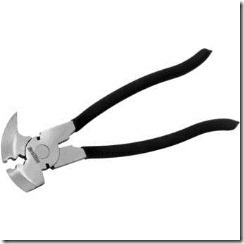 a good pair of thick leather gloves, I would climb on and a fence fixin’ we would go. The job was pretty much routine, a broken or sagging stretch of page wire was repaired with a length of barb wire. At a rotten post the staples would be pulled, the post removed, a new hole made beside it with the crowbar, the post set in then pounded further in the ground with the mall then came my job, handing new staples to father to hold the wire in place on the post. This routine was held up a bit when in a meadow about midway along the West boundary we come to the remains of a foundation with a well mostly filled in over time, we take a break to explore this new, to me, exciting place (where I would return many times over the years playing imaginary roles of adventure).
a good pair of thick leather gloves, I would climb on and a fence fixin’ we would go. The job was pretty much routine, a broken or sagging stretch of page wire was repaired with a length of barb wire. At a rotten post the staples would be pulled, the post removed, a new hole made beside it with the crowbar, the post set in then pounded further in the ground with the mall then came my job, handing new staples to father to hold the wire in place on the post. This routine was held up a bit when in a meadow about midway along the West boundary we come to the remains of a foundation with a well mostly filled in over time, we take a break to explore this new, to me, exciting place (where I would return many times over the years playing imaginary roles of adventure).
A short digression for a bit of history. Apparently way back when the area was opened up, the road from Brigham passed through here and the Taber who settled on this farm built his house here. Years later as more settlers came the roads were built along the range (concession in Qntario) lines thus the Brigham road was moved a bit south. Now Taber being a man of ingenuity, skidded the house to the present location which he lived in until the main house (grandfather’s house) 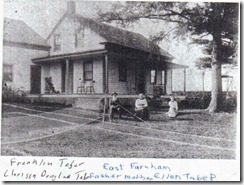 was built, over the years it was expanded to become our house.
was built, over the years it was expanded to become our house.
Break over we finish the line fence, progress to the road fences followed by this years pasture fences. The final fence job is taking down the snow fence set about a hundred feet back from the road to the hill North of the house on the Adamsville road.


The seasons change but the cows still have to be milked twice daily, 6am and 5pm on our place, (the only change in this routine occurs twice a year when due to a stupid idea Benjamin Franklin dreamed up we go on/off Daylight Saving Time fortunately El Salvador doesn’t follow this foolishness) so morning chores still have the same routine. As cows like to stick to a routine, a change stresses them resulting in decreased milk production so during the last couple weeks in April milking time would be moved forward 5 minutes a day (some moved it 2 minutes/day over the whole month and we had a neighbour who stayed on standard time all year). With the days slowly creeping longer while the temperature grows warmer, cows sensing a change in the weather grow restless in their stanchions.
With sugaring over the snow gone the fields drying under the suns rays the next job on the farm is spreading the manure from the pile that has grown steadily larger each winters day. Father, who has a severe dislike for horses, hitches the new International Harvester Farmall C tractor 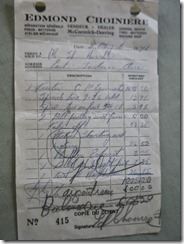 , purchased the previous year to replace the old doodlebug,
, purchased the previous year to replace the old doodlebug,

to the spreader, pulls alongside the pile and with a dung fork begins the tedious chore of loading tons of manure to be spread on the fields giving much needed nutrients to the soil. Fortunately (as the dung fork or any other version of the ‘Mexican dragline’ were never on my list of favourite tools to operate), I am too small to do anything but supervise this chore.
After a light skiffing of manure has been applied to the pastures, one sunny morning there comes a much anticipated (by man and beast alike) change in the morning chore routine for instead of opening the mow door for hay, the west stable door is opened wide, as the first stanchion opened the rest raise ruckus while awaiting their turn at a days freedom to go frolicking in pasture’s green grass in the spring sun. In a couple weeks, when the night-time temperature has moderated the cows will be turned out after the evenings milking as well eliminating much of the stable chores as the young cattle will also be let out into the south bush lot and meadows for the summer, only the bull and small calves are left in the barn. On a slack spring day after the cows are turned out the stable will be thoroughly cleaned, floor walls and ceiling in preparation for a coat of whitewash 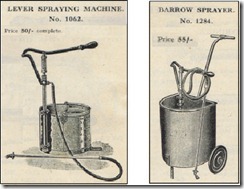
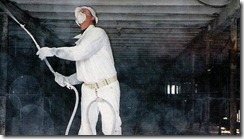 (a requirement of the Guaranteed Pure Milk Co.)
(a requirement of the Guaranteed Pure Milk Co.) 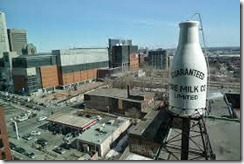 to be applied.
to be applied.
With sugaring history, the cattle out to pasture and the stable all spiffed up for when the milk inspector with a touch of spring fever leaves his office in the city for a drive in the country to stop by it’s seeding time.
The first job is hooking the tractor to a set of spring tooth harrows  (they were a better option than discs on our stone littered fields) 3 passes made a nice smooth seed bed. Next came a job I could help with picking stones, grandfather would hook the team to the stone boat
(they were a better option than discs on our stone littered fields) 3 passes made a nice smooth seed bed. Next came a job I could help with picking stones, grandfather would hook the team to the stone boat  throw a chain and crowbar on board and off we would go. I could handle the small ones while father and grand father picked the larger ones, occasionally we came to one large enough to need the crowbars help. There were also a few big ones that required placing the chain around it so that when a horse was unhooked from the boat then to the chain the pull would roll it onto the boat, once the boat was loaded grandfather drove it to the fields fence line stone pile to be unloaded. Needless to say that after a days stone picking there was no problem falling asleep.
throw a chain and crowbar on board and off we would go. I could handle the small ones while father and grand father picked the larger ones, occasionally we came to one large enough to need the crowbars help. There were also a few big ones that required placing the chain around it so that when a horse was unhooked from the boat then to the chain the pull would roll it onto the boat, once the boat was loaded grandfather drove it to the fields fence line stone pile to be unloaded. Needless to say that after a days stone picking there was no problem falling asleep.
Father used a seven year rotation so the farm’s tillable acreage was broken up into seven fields of approximately 6 acres each with one field field ploughed every fall to be spring seeded in a hay mix of red clover, alfalfa, timothy and brome grass with a cover crop of oats. The oats were the first years crop, followed by four yrs of hay with 2 yrs pasture making up the seven yrs.
With the seedbed prepared, any troublesome stones removed seeding could begin. First father pulled the 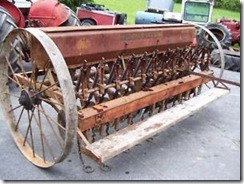 McCormick–Deering
McCormick–Deering 
 11 run seed drill from its storage spot in the old stable, greased and oiled it up making sure nothing had seized over the winter and was in proper working order with none of the seed tubes plugged (this same seed drill was used for all crops on the farm for for over 40 years from my earliest memory in the ‘40’s until the last crop father planted in early ‘80’s). The trailer was then loaded with bags of fertilizer, seed oats and grass seed, it was then taken to the field to be seeded and parked on the headland near the center of the field. Next the grass seed box was filled with a mixture of clover/alfalfa seed, the grain seed box filled with a mixture of oats/timothy/brome grass, lastly the fertilizer compartment is filled to the brim.
11 run seed drill from its storage spot in the old stable, greased and oiled it up making sure nothing had seized over the winter and was in proper working order with none of the seed tubes plugged (this same seed drill was used for all crops on the farm for for over 40 years from my earliest memory in the ‘40’s until the last crop father planted in early ‘80’s). The trailer was then loaded with bags of fertilizer, seed oats and grass seed, it was then taken to the field to be seeded and parked on the headland near the center of the field. Next the grass seed box was filled with a mixture of clover/alfalfa seed, the grain seed box filled with a mixture of oats/timothy/brome grass, lastly the fertilizer compartment is filled to the brim.
The tractor with drill is driven to the end of the field with grandfather riding on the board running across the back of the drill where he lowers the lever putting the disc seed furrow openers in the soil which engages the mechanism that regulates the pre-set seed flow. At the end of the field grandfather raised the lever disengaging the drill, father turns the rig around so one wheel of the drill follows in the wheel track of the previous trip, grad father lowers the lever and another round is made. This continues with breaks to refill the seed and fertilizer boxes until the field is seeded, the trailer is then moved so a final two passes can be made to seed the headlands. The drill is then emptied, cleaned with the fertilizer compartment abundantly oiled to prevent corrosion then parked back in it’s place. Any remaining seed or fertilizer on the trailer is put back in storage. Finally the C is hooked to the 3 drum land roller which not only compacts the seed bed it also makes the field smoother for hay cutting. Once the roller is back in its storage spot, another years seeding is done.
On the eastern boundary of the farm on the south side of the East Farnham road there is an irregular shaped field of about an acre cut off from the rest of the farm by a fairly deep drainage ditch making it unfriendly to loads of loose hay so it was the designated turnip field. Once the new hayfield seeding was complete father would work up that field with the harrows, then grandfather would hitch one horse to turnip planter 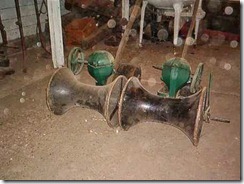 to finish the fields springs work.
to finish the fields springs work.
As father was an International man and the local dealer carried their toys I had the full line of IH machinery, a Farmall H tractor, manure spreader, 2 furrow drag plow, disc harrows, TD 24 dozer plus a single axle highway tractor complete with van trailer with opening barn doors. There was also other tin toys a hay mower, dump truck, mobile crane (these toys were still on the farm when I returned home from the west with my wife and Leon they were played with by a 2nd generation, they came to ON with me to be left with Shane when he bought the Kendal house for a 3rd generations enjoyment), these combined with my Meccano set 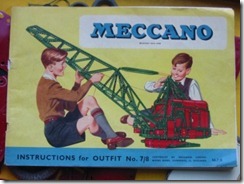 gave me the ability to do any job so while I was waiting for my legs to grow long enough to operate the real C, I could practice doing the jobs with my toys. In between these spring jobs I would take play breaks riding my tricycle
gave me the ability to do any job so while I was waiting for my legs to grow long enough to operate the real C, I could practice doing the jobs with my toys. In between these spring jobs I would take play breaks riding my tricycle  around or practicing backing up with the 2 wheel trailer that attached to the back with a draw pin just like the tractor or riding my wagon
around or practicing backing up with the 2 wheel trailer that attached to the back with a draw pin just like the tractor or riding my wagon 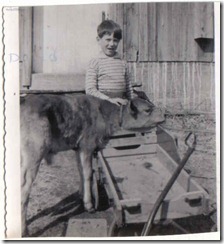 down the barn bridge hill,
down the barn bridge hill,  even got so I could do that backwards to the dismay of some city visitors whose silliness thought it dangerous
even got so I could do that backwards to the dismay of some city visitors whose silliness thought it dangerous
Back at the house from the turnip field with the harrows father would work up the vegetable/flower garden, being careful not to disturb the horseradish patch nor the asparagus stand. Grandfather could then remove his prizewinning gladiola bulbs from the barn floor in the haymow where they were dried during the winter to place them back in the warm earth where they would flourish (until Labour Day to win a 1st place red ribbon at the Brome County Fair). I would then help mother and grandmother with the garden that would supply the bulk of our veggies for the year, my favourites being the parsnips dug as soon as the frost is out of the ground and asparagus boiled then smothered in melted cheese.
The garden is bordered on the west side by mauve lilac bushes 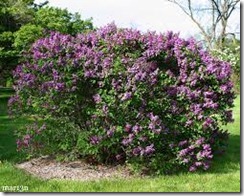 whose blossoms were the harbingers of spring, at the south west end are the asparagus canes, the horseradish patch then towards the north end lay a plot reserved for the gladiolas, iris, tulip bulb plants, working east are peas, beans, pole, green (which to this day I hate) and yellow (don’t mind them), now comes a couple rows of sweet corn followed next by the patch I liked planting best pumpkins, squash and ornamental gourd seeds best as they were nice and large for easier handling. Now we come to the pansy bed containing at least a gazillion of the purtiest flower in the garden. Now we leave a vacant space for the beefsteak ‘maters to be transplanted after May 24th when the danger of night-time frost has past next come the mundane veggies, carrots, beats etc., yur rabbit food, lettuce, spinach, cabbage, parsley finally there are a couple rows of ‘taters for new potatoes in the summer (the main potato crop for winter storage is planted later in a patch alongside the seeded field) as the garden ends at the roadside the inevitable ditch lilies
whose blossoms were the harbingers of spring, at the south west end are the asparagus canes, the horseradish patch then towards the north end lay a plot reserved for the gladiolas, iris, tulip bulb plants, working east are peas, beans, pole, green (which to this day I hate) and yellow (don’t mind them), now comes a couple rows of sweet corn followed next by the patch I liked planting best pumpkins, squash and ornamental gourd seeds best as they were nice and large for easier handling. Now we come to the pansy bed containing at least a gazillion of the purtiest flower in the garden. Now we leave a vacant space for the beefsteak ‘maters to be transplanted after May 24th when the danger of night-time frost has past next come the mundane veggies, carrots, beats etc., yur rabbit food, lettuce, spinach, cabbage, parsley finally there are a couple rows of ‘taters for new potatoes in the summer (the main potato crop for winter storage is planted later in a patch alongside the seeded field) as the garden ends at the roadside the inevitable ditch lilies  add colourful orange border.
add colourful orange border.
In addition to the main garden there are other berry plots and flowers scattered around the yard, growing by the stable’s east wall are a couple bushes of brilliant yellow wild roses, moving towards the house the lower part of south wall is hidden by honeysuckle 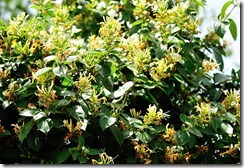 with their clustering flowers, accenting the front windows on the east side of our house are two window-boxes of red geraniums, beside the north wall of grandfather’s house nestled in the shade of white lilacs in a small space before the cedar hedge that borders the yard is a patch of lily-of-the-valley
with their clustering flowers, accenting the front windows on the east side of our house are two window-boxes of red geraniums, beside the north wall of grandfather’s house nestled in the shade of white lilacs in a small space before the cedar hedge that borders the yard is a patch of lily-of-the-valley 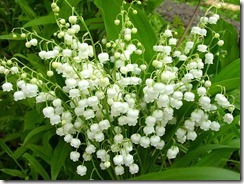 with their tiny white bell-shaped blooms. Hiding a good portion of the west wall of our house is a plethora of golden glow.
with their tiny white bell-shaped blooms. Hiding a good portion of the west wall of our house is a plethora of golden glow.  Continuing to the back of the yard we come to an arbour of purple grapes, moving west we spy a rhubarb patch with it’s neighbouring strawberry one (no pie can beat strawberry-rhubarb) behind these lie the current bushes both red and white. Finally to the north of the laneway between the garage and back-field is the extensive raspberry patch, mainly purple with a few canes of black or red for variety.
Continuing to the back of the yard we come to an arbour of purple grapes, moving west we spy a rhubarb patch with it’s neighbouring strawberry one (no pie can beat strawberry-rhubarb) behind these lie the current bushes both red and white. Finally to the north of the laneway between the garage and back-field is the extensive raspberry patch, mainly purple with a few canes of black or red for variety.
While not really part of the garden, out behind the barn in the calf pasture is an unkempt old orchard with a crab-apple tree, some small apples still form on the tree which while still green make a nice tart treat when rubbed on the pasture’s cow salt block, perhaps the cow-spit adds to the taste? Perhaps that’s why I enjoy a bottle of Smirnoff Green Apple at the end of the day. 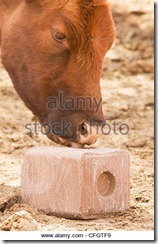
The transition from winter to spring meant that the stable chores were greatly reduced as the cattle were now living outside, less clothing was needed, heating the house was no longer needed so only the cook stove had to be fuelled and cleaned. March brought the last Farm Radio Forum broadcasts of the season so the Monday night meetings were adjourned until after fall’s harvests. There was now a bit of a break to catch up on other chores pertaining to farm life prior to the arrival of summer’s haying season!

